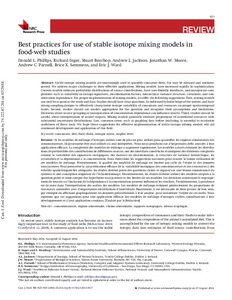| dc.contributor.author | Phillips, D.L. | |
| dc.contributor.author | Inger, R. | |
| dc.contributor.author | Bearhop, S. | |
| dc.contributor.author | Jackson, A.L. | |
| dc.contributor.author | Moore, J.W. | |
| dc.contributor.author | Parnell, A.C. | |
| dc.contributor.author | Semmens, B.X. | |
| dc.contributor.author | Ward, E.J. | |
| dc.date.accessioned | 2018-10-26T13:21:17Z | |
| dc.date.available | 2018-10-26T13:21:17Z | |
| dc.date.issued | 2014 | |
| dc.identifier.citation | Phillips, D.L., Inger, R., Bearhop, S., Jackson, A.L. Moore, J.W., Parnell, A.C., Semmens, B.X. and Ward, E.J. (2014) Best practices for use of stable isotope mixing models in food-web studies. Canadian Journal of Zoology, 92, pp.823–835 . DOI:/10.1139/cjz-2014-0127 | en_US |
| dc.identifier.uri | http://hdl.handle.net/11329/538 | |
| dc.identifier.uri | http://dx.doi.org/10.25607/OBP-116 | |
| dc.description.abstract | Stable isotope mixing models are increasingly used to quantify consumer diets, but may be misused and misinterpreted. We address major challenges to their effective application. Mixing models have increased rapidly in sophistication. Current models estimate probability distributions of source contributions, have user-friendly interfaces, and incorporate complexities such as variability in isotope signatures, discrimination factors, hierarchical variance structure, covariates, and concentration dependence. For proper implementation of mixing models, we offer the following suggestions. First, mixing models can only be as good as the study and data. Studies should have clear questions, be informed by knowledge of the system, and have strong sampling designs to effectively characterize isotope variability of consumers and resources on proper spatio-temporal scales. Second, studies should use models appropriate for the question and recognize their assumptions and limitations. Decisions about source grouping or incorporation of concentration dependence can influence results. Third, studies should be careful about interpretation of model outputs. Mixing models generally estimate proportions of assimilated resources with substantial uncertainty distributions. Last, common sense, such as graphing data before analyzing, is essential to maximize usefulness of these tools. We hope these suggestions for effective implementation of stable isotope mixing models will aid continued development and application of this field. | en_US |
| dc.language.iso | en | en_US |
| dc.subject.other | Isotopic ratios | en_US |
| dc.title | Best practices for use of stable isotope mixing models in food-web studies. | en_US |
| dc.type | Journal Contribution | en_US |
| dc.description.refereed | Refereed | en_US |
| dc.format.pagerange | pp.823-835 | en_US |
| dc.identifier.doi | 10.1139/cjz-2014-0127 | |
| dc.subject.parameterDiscipline | Parameter Discipline::Chemical oceanography::Isotopes | en_US |
| dc.bibliographicCitation.title | Canadian Journal of Zoology | en_US |
| dc.bibliographicCitation.volume | 92 | en_US |
| dc.description.eov | stable carbon isotopes | en_US |
| dc.description.bptype | Best Practice | en_US |
| dc.description.bptype | Guide | en_US |
| obps.resourceurl.publisher | http://www.nrcresearchpress.com/doi/pdf/10.1139/cjz-2014-0127 | en_US |
 Repository of community practices in Ocean Research, Applications and Data/Information Management
Repository of community practices in Ocean Research, Applications and Data/Information Management
